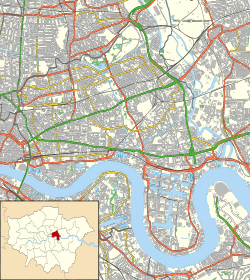History
The building was commissioned to replace the Old Town Hall, located 1.7 miles (2.7 km) due south on Poplar High Street. [2] [3] The site chosen for the new building had been occupied by a 19th century vestry hall. [4]
The foundation stone for the new building was laid by the former mayor, Alderman Charles Key, on 8 May 1937. [5] [6] It was designed by Culpin and Son in the Modernist style in a shape that took the form of a trapezoid. [1] [7] The design involved a rounded frontage at the junction of Bow Road and Fairfield Road; there were layers of continuous stone facing panels above and below a continuous band of glazing on the first, second and third floors. [4] The Builders, a frieze by sculptor David Evans on the face of the building, was unveiled by George Lansbury at the official opening of the building on 10 December 1938. [1] Made of Portland stone panels, it commemorated the trades constructing the town hall and symbolised the borough's relationship with the River Thames and the youth of Poplar. [8] [9] The principal rooms were the council chamber, the mayor's parlour and an assembly hall which benefited from a sprung Canadian maple dance floor. [10] The architect, Edwin Culpin, claimed it was "the first town hall in this country to be erected in the modern style". [11]
The building was proclaimed by the council to be the first town hall to be erected in the modernist style [4] but ceased to function as the local seat of government when the enlarged London Borough of Tower Hamlets was formed in 1965. [12]
After being used as workspace by the council until the mid-1980s, the town hall was sold in the 1990s to a developer who added a roof extension and converted it for commercial use. [10] The complex had included a theatre, with a 35 feet (11 m) proscenium arch, which was demolished by the developer in 2000. [13] The complex was subsequently used as a business centre. [4]
The roof extension containing private homes was damaged by a fire on 23 August 2023. [14]
This page is based on this
Wikipedia article Text is available under the
CC BY-SA 4.0 license; additional terms may apply.
Images, videos and audio are available under their respective licenses.

